SIGHTS OF INTEREST
You cannot hope to get know any city in the world without strolling down a few streets. It would be a crime to claim that you have seen Moscow without spending several days on foot. You will feel adventurous as you step out from your hotel or apartment on your own and boldly set out in whichever direction. There is no better way to get to know Moscow, or its citizens, than by strolling around, studying faces, randomly walking into stores to see what's for sale, even if you buy nothing.
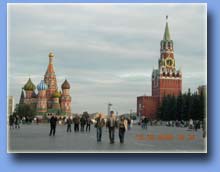 |
 |
Let's begin with Red Square or Krasnaya Ploshchad'. Krasnaya in Russian translates as "red" and "beautiful". Red Square is the epicenter of Russia. Originally it was the only dry side of the Kremlin and had a water channel until Napoleon's occupation of Moscow. Battles against the invading Tartars who tried to overtake the Kremlin raged here. From the 1500's on, it was the market place of Moscow, named veliky torg or Great Marketplace, as well as the site of festivals and religious processions. Till the end of 17th century Red Square frequently witnessed public tortures of felons. A mass slaughter of the boyare (medieval Russian noblemen) and their retainers took place here during the reign of Ivan the Terrible. Stepan
Razin, a peasant leader and Cossack rebel, was executed in 1671, and 28 years later Peter the Great had many of his streltsy (musketeers) publicly put to death in wholesale executions on the square. Peter himself cut off more than a hundred of their heads (they fell out of favor opposing Peter's liberal program). Military parades took place here twice a year during the Soviet time.
Today you can casually stroll from one end to the other and admire its vastness and beauty. But when
Lenin's Tomb (Mavzoley Lenina) is open for visitors it's cordoned off.
Red Square is bounded by the Kremlin wall and the GUM department store. As you step on to the square indulge your eyes on St. Basil's Cathedral which rises from the slope at the south end of the square. It was erected by Ivan the Terrible in 1561 to celebrate the liberation of the Russian state from the Tartars. People say, Ivan planned to build eight churches on the square, each one to be dedicated to the saint on whose day he won his battles. But after seven wooden structures were built he ordered to tear down them and strike with the present brick cathedral in traditional Russian style with onion domes situated over the nine chapels. Legend says that when the cathedral was completed the two architects were blinded so the couldn't never create an equally beautiful sight. It was looted by the Poles in 1611 and six years later the cathedral got its present colorful appearance. During the Soviet time the cathedral was closed by Stalin who wanted to tear it down just to get a better access to Red Square. The cathedral was saved by an architect Pyotr Baranovsky who threatened to kill himself if Stalin didn't spare St. Basil's. Stalin did but the architect ended up in prison.
The monument to Minin and Pozharsky stands in front of St. Basil's Cathedral. The statue of the merchant Kuzma Minin rallied his fellow Russians in 1611 to drive out Polish invaders and Prince Dmitry Pozharsky led this militia to march to Moscow and fight a decisive battle on Aug, 24 in 1612. The ornaments on the pedestal of the monument depict the citizens of Nizhny Novgorod collecting funds for their struggle and the expulsion of the Poles.
On the northern corner of Red Square and Nikolskaya Street stands the rebuilt
Kazan Cathedral, a monument to Russia's victory over the Poles in 1612. The original cathedral was dedicated in 1636, but destroyed 300 years later and turned into a public restroom. The icon of the Kazan Virgin accompanied Prince Pozharsky on his campaigns was moved to St. Petersburg in 1710.
Historical Museum is on this corner too, originally the first building of the Moscow University, founded in 1755.
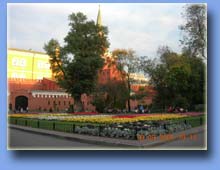 |
|
Alexander's Garden |
 |
|
Manezhnaya Square |
|
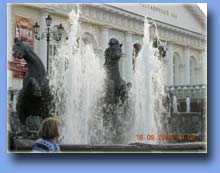
|
|
Manezhnaya Square |
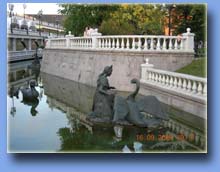 |
You can walk from here to Alexander's Garden (Alexandrovsky Sad) located between the Kremlin and Manezhnaya Street. The gardens were laid out by Osip Bove between 1819 and 1822 and named after Tsar Alexander I, the eldest son of Paul I and grandson of Catherine the Great. The Neglinka river, a Moscow river tributary that once snaked its way along the western wall of the Kremlin and formed one of the three water barriers protecting the Kremlin, was diverted into an aqueduct beneath the Gardens after the catastrophic fires of 1812. Gardeners from all over Russia were invited to plant trees, shrubs and flowers. After the reconstruction of Manezhnaya Square the river flows at the edge of Alexandrovsky Sad, but only for a few hundred feet, and begins and ends in fountains. The former bridge over the river is utilized now as a passageway to the Kremlin. You'll find a multi-level underground shopping center and a parking lot at the northern end of Alexandrovsky Sad, the rest of the Gardens is an oasis of peace: there are plenty of benches to sit and relax here.
There is a Tomb of the Unknown Soldier at the foot of the Kremlin wall in Alexandrovsky Sad, where the Eternal Flame of memory burns. The Tomb has the inscription: "Your name is unknown, your feat
immortal". This red granite memorial to the heroes of World War II was unveiled on May 8, 1966, on the eve of Victory Day to commemorate the anniversary of the defeat of German forces in battles near Moscow. The remains of the Unknown Soldier were taken from a mass grave at the village of
Kryukovo, at the 41st kilometer of the Leningrad Highway, where enemy troops attacking Moscow had been halted. To the right of the Tomb are six urns holding soil from the six cities that resisted the German occupation: Odessa,
Sevastolop, Volgograd, Kiev, Brest, St. Petersburg. War veterans and other citizens come to the tomb to put the flowers and to pay their respects on the day of victory over Nazi Germany, celebrated in Russia on 9th of May.
Tverskaya Street runs to the northwest from the north of the Kremlin, Manezhnaya Square and National Hotel. It's a splendid idea to walk the whole length of this street at least once, along Yermolova Theater, Central Telegraph Office, Prince Yuri Dolgoruky equestrian statue, Pushkin Square, Tchaikovsky Concert Hall and Satira Theater on Triumfalnaya Square, - it will take you well over one hour. From Triumfalnaya Square Tverskaya Street changes its name and leads you to Belorussky Railway Station as the First Tverskaya-Yamskaya Street. From the Bellorussky station, Tverskaya becomes Leningradsky Avenue and goes directly to Sheremetyevo-2 International Airport.
The name of Tverskaya Street goes from its connection of Moscow with the ancient Russian town of
Tver, 160 miles northeast of Moscow. Tverskaya Street was an initial part of the direct route, via
Tver, to the new capital St. Petersburg. By the 16th century, Tverskaya was a well-known trade route. Even after Peter the Great transferred the capital from Moscow to St. Petersburg, the new tsars entered Moscow along Tverskaya Street. Before the Revolution, the street was well known for its fashionable stores, luxurious hotels, and aristocratic mansions. Originally a tiny, uneven, winding road, Tverskaya's width was tripled in the mid-1930s when some houses were torn down and others were moved back. The construction of the many large buildings that you see today, with shops on the ground floor, began soon afterwards. Today this street, still a bit ragged, again boasts some of the most expensive real estate and the most exclusive stores in the capital such as
Yeliseyevsky Gastronom.
 If you go to southwest from the Kremlin you'll come to the
Cathedral of Christ the Savior. It was erected in 1883 to honor those killed in the Napoleonic War of 1812. The construction following for 46 years by 100 000 workers was commissioned by Tsar Alexandr I. To make room for the original cathedral, the tsar had a convent torn down and the legend has it that in retaliation the nuns cursed the site. The 338 feet tall, 72 120 square foot cathedral could accommodate 10 000 worshippers. Fifty years later the Communists wanted to build the Palace of the Soviets here, which was to be the tallest building in the world at that time, crowned with a gargantuan 301-foot-tall statue of Lenin. The cathedral was blown up in 1931. Thus it was one of the first buildings that fell victim to Stalin's reconstruction. But as the huge soft-soiled foundations of the future palace kept shifting, the plans were abandoned. In 1960 on order of Nikita Khrushchev a year-round heated open-air swimming pool was built in this place. In typically Soviet fashion, it was so large that 2 000 people could swim in it at any once time. By the 1990s they claimed that the pool's steam was damaging the artwork in the nearby Pushkin Museum and eroding the foundations of other buildings. In 1994, Moscow's mayor resurrected the idea of rebuilding the cathedral in time for the 850th anniversary of Moscow in 1997. So the cathedral was basically finished for the 850th anniversary and its painting took several more years. Now it's one of the most visible structures in Moscow. If you go to southwest from the Kremlin you'll come to the
Cathedral of Christ the Savior. It was erected in 1883 to honor those killed in the Napoleonic War of 1812. The construction following for 46 years by 100 000 workers was commissioned by Tsar Alexandr I. To make room for the original cathedral, the tsar had a convent torn down and the legend has it that in retaliation the nuns cursed the site. The 338 feet tall, 72 120 square foot cathedral could accommodate 10 000 worshippers. Fifty years later the Communists wanted to build the Palace of the Soviets here, which was to be the tallest building in the world at that time, crowned with a gargantuan 301-foot-tall statue of Lenin. The cathedral was blown up in 1931. Thus it was one of the first buildings that fell victim to Stalin's reconstruction. But as the huge soft-soiled foundations of the future palace kept shifting, the plans were abandoned. In 1960 on order of Nikita Khrushchev a year-round heated open-air swimming pool was built in this place. In typically Soviet fashion, it was so large that 2 000 people could swim in it at any once time. By the 1990s they claimed that the pool's steam was damaging the artwork in the nearby Pushkin Museum and eroding the foundations of other buildings. In 1994, Moscow's mayor resurrected the idea of rebuilding the cathedral in time for the 850th anniversary of Moscow in 1997. So the cathedral was basically finished for the 850th anniversary and its painting took several more years. Now it's one of the most visible structures in Moscow.
The Novodevichy (New Maiden) Convent will be the next our stop. It's an outstanding example of early 16th century architecture: a cluster of sparkling domes behind handsome turreted walls, full of history and treasures. It's called "new" because there was an older monastery here in the 14th century. Novodevichy was a powerful fortress at the southwest approaches to Moscow. It was founded in 1524 under the reign of Vassily III in honor of his 1514 recapture of Smolensk from the Lithuanians who controlled it for more than a hundred years. From early on, noblewomen would retire here, some willingly, some not. Now the convent is being returned to religious use. The best views of it are from across the pond to its north.
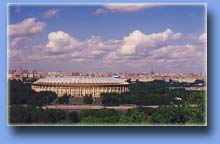 Let's go to the Sparrow Hills (Vorobyovy Gory) now to get the best view of the city. You'll overlook the city from the hill of 85 meters high and see the greater part of Moscow: the wide loop of Moskva river with the gentle slope of the Sparrow Hills continuing on the left, the housing estates behind the Mosfilm Studios, the Kiev Raiway Station, the tower of the Hotel Ukraine, the golden domes of the Novodevichy Convent and of the Kremlin cathedrals (which are visible in good weather),
Neskushny Sad, and many other buildings. Moscow University's 32-story 787-foot high-rise towers over the 220 acre campus will be behind you. It was the tallest structure in Europe when built, except for the Eiffel Tower. It was built by thousands of slave workers from 1949 on and inaugurated in 1953. This is one of the so-called "Seven Sisters", buildings of repelling Gothic appeal. Moscow University is the largest educational institution in the country. Let's go to the Sparrow Hills (Vorobyovy Gory) now to get the best view of the city. You'll overlook the city from the hill of 85 meters high and see the greater part of Moscow: the wide loop of Moskva river with the gentle slope of the Sparrow Hills continuing on the left, the housing estates behind the Mosfilm Studios, the Kiev Raiway Station, the tower of the Hotel Ukraine, the golden domes of the Novodevichy Convent and of the Kremlin cathedrals (which are visible in good weather),
Neskushny Sad, and many other buildings. Moscow University's 32-story 787-foot high-rise towers over the 220 acre campus will be behind you. It was the tallest structure in Europe when built, except for the Eiffel Tower. It was built by thousands of slave workers from 1949 on and inaugurated in 1953. This is one of the so-called "Seven Sisters", buildings of repelling Gothic appeal. Moscow University is the largest educational institution in the country.
 |
 |
 |
 |
Next our stop will be at the enormous Victory Park, a park to honor the millions who died and those who survived World War II. It was the edge of Victory Park on Poklonnaya Hill (the Bowing Hill) that Napoleon stood in 1812, looking at the Kremlin and awaiting the keys to the city of Moscow, which would symbolize the city's surrender to the invader. The hill has since been leveled to a hillock that even Napoleon wouldn't recognize and today you cannot see very far from it. It was leveled to make room for the Victory Park. The huge complex was 15 years in making and was finally completed in 1995. It consists of an obelisk, a large museum, a church, and several monuments.
A narrow obelisk with Nike, the Greek goddess of victory, flanked by two angels with golden trumpets at her side, soars more than 410 feet skyward in the center of the square. It displays battle scenes and the names of Soviet cities that were designated as hero-cities because of their contribution during the war. At its base, St. George, the symbol of the city of Moscow, pitches a final, mortal lance from his rearing horse into the dying, dissected dragon of fascism.
The multi-level Museum of the Great Patriotic War behind the obelisk is the largest such memorial to veterans of World War II in Moscow.
A handsome stylized ancient-style church is the first one built since the 1917 Revolution. Instead of paintings, it is decorated with relief panels in bronze. The icon of St. George on the wall will be to your left as you enter.
The Triumphal Arch stands on the eastern edge of the Victory Park, in the middle of Kutuzovsky Avenue. It was erected at the Belorussky Railway station in 1834 to commemorate Russia's victory over Napoleon. In the 1930's it was razed, but resurrected and moved here in the 1960's, when Tverskaya Street was widened.
And the final stop let's do at the Old Arbat Street (Stary Arbat). It's 500 years old. It's about one kilometer long and traces its origins to the road that led to the ancient city of Smolensk. This are was first mentioned in the 15th century. Paved with brick, Stary Arbat was Moscow's first pedestrian road. In 1812, when Napoleon occupied the city, most of Stary Arbat Street was burned to the ground. Because of that, its appearance was altered completely and new mansions, some of which you can still see, were built in the Empire style. Arbat Street is full of musicians, singers, artists, photographers, entrepreneurs, beggars, and acts of every conceivable shade like most counterpart streets and promenades all over the world. There are many antique stores and bookstores here.
You'll find a lot of souvenirs here such as matryoshka (a wooden nesting doll, painted in bright colors and lacquered; it can consist of from three to 40 pieces that fit inside one another, with the smallest sometimes the size of a thimble), ceramic tea and coffee services, samovars, dishes, vases and figurines made of
Gzhel porcelain and painted with a distinct blue glaze on a white background; wood objects uniquely painted by the artisans of
Khokhloma, a village on the Volga river; carved wooded toys with moving parts of
Bogorodskoye village; russian lace in the form of tablecloths, bedspreads and napkins; bright red or deep blue cotton shawls made in
Pavlovsky Posad, - these head scarves were worn before the Revolution by every Russian woman;
shkatulky, lacquered papier-mache objects in the form of miniature boxes made in
Fedoskino and Palekh villages.
There are so many places to see in Moscow! But it's impossible to describe all of them here. Write us and we'll give you the information you need!
You are welcome to Moscow!
|